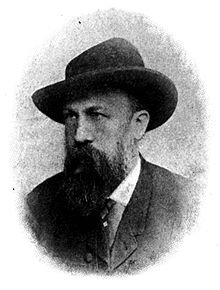Ludwig Stieda
Christian Hermann Ludwig Stieda (born November 7, 1837 in Riga , † November 19, 1918 in Gießen ) was a German-Baltic anatomist in Dorpat and Königsberg.
biography
Stieda attended the governorate high school in Livonia governorate . After graduating from high school, he studied medicine at the University of Dorpat , the Hessian Ludwig University , the Friedrich Alexander University and the University of Vienna . In 1861 he was awarded a Dr. med. PhD. The following year he completed his habilitation in anatomy and became a private lecturer at the University of Dorpat. From 1864 he was a prosector at the Anatomical Institute. 1866–1875 he was an associate professor , from 1875 full professor for anatomy at the University of Dorpat.
From 1885 to 1912 he was full professor of anatomy at the Albertus University in Königsberg . In 1887/88 he was dean of the medical faculty . Among the preclinicals , he had a reputation for failing corporate “saber students”. During the five-semester activity (until 1897), quite a few corps boys went to other universities (Erlangen, Würzburg) without a tape even before they were inactivated . They did the Physikum in the 4th semester and then returned to Königsberg as active participants for their 5th and 6th semesters. At the age of 75 years he was at the Albertus University emeritus . He moved to Giessen because his wife's relatives still lived there. He met Mathilde Langermann (1831–1908) from Ortenberg (Hesse) as a student in Giessen and married in 1866. Stieda died in Giessen at the age of 81. His sons are the surgeons Alexander Stieda (1875–1966) and Alfred Stieda (1869–1945). His estate is kept by the University and State Library of Saxony-Anhalt .
Baer estate
Stieda was already looking after the estate of Karl Ernst von Baer (1792–1876) in Dorpat . According to the will of the heirs, the legacies were divided into three parts. After he had started to list them, Stieda took the third part of the estate with him to Königsberg. It comprised Baer's scientific correspondence with 4,400 letters from scholars from all over the world ( Alexander von Humboldt , Carl Gustav Carus ) as well as other writings and manuscripts. He also kept the estate with him in Gießen. After Stieda's death, the heirs handed over the estate to the Giessen University Library . It fell into oblivion and was rediscovered in 1971.
Honors / memberships
- 1878–1885 co-director and honorary member of the Society for History and Archeology of the Baltic Provinces of Russia .
- 1885 Scholarly Estonian Society
- 1886 German Academy of Sciences Leopoldina
- 1895 Natural Scientists Association in Riga
- 1898 Military Medical Academy SM Kirov
- 1904 corresponding member of the Russian Academy of Sciences in Saint Petersburg.
- 1907 Society of General Practitioners in Riga
Works
- On the homology of the thoracic and pelvic limbs of humans and vertebrates . Wiesbaden: JF Bergmann, 1897.
- Anatomical-archaeological studies. Wiesbaden: JF Bergmann, 1900.
- The embryologist Sebastian Graf von Tredern and his treatise on the hen egg. Wiesbaden: JF Bergmann, 1901.
- Research on human hair. Wiesbaden: JF Bergmann, 1910.
literature
- Paul Eisler: Ludwig Stieda † . Anatomischer Anzeiger 52 (1919), pp. 131–144 (with bibliography)
Web links
Individual evidence
- ↑ Dissertation: On the spinal cord and individual parts of the brain by Esox Lucius L.
- ↑ Habilitation thesis: About the capillary system of the spleen .
- ^ Rüdiger Döhler (ed.): Corps Masovia. The 175-year history of Königsberg's oldest and Potsdam's first corporation in the 21st century. Munich 2005, ISBN 3-00-016108-2 , p. 178.
- ↑ a b Permafrost and Embryos - The "Humboldt of the North" Karl Ernst von Baer (geb.uni-giessen.de)
- ↑ Leopoldina [1]
- ↑ http://sundoc.bibliothek.uni-halle.de/nachlaesse/stieda/stieda1.htm
- ^ Foreign members of the Russian Academy of Sciences since 1724. Christian Hermann Ludwig Stieda. Russian Academy of Sciences, accessed October 24, 2015 .
| personal data | |
|---|---|
| SURNAME | Stieda, Ludwig |
| ALTERNATIVE NAMES | Stieda, Christian Hermann Ludwig (full name) |
| BRIEF DESCRIPTION | German-Baltic anatomist |
| DATE OF BIRTH | November 7, 1837 |
| PLACE OF BIRTH | Riga |
| DATE OF DEATH | November 19, 1918 |
| Place of death | to water |

